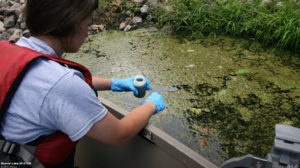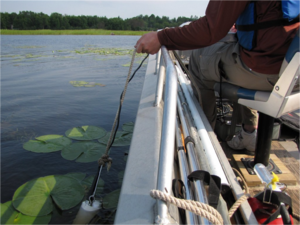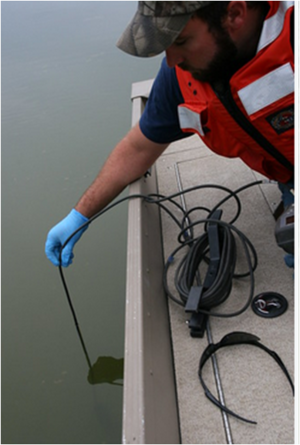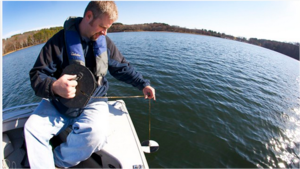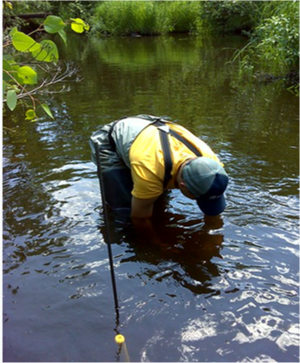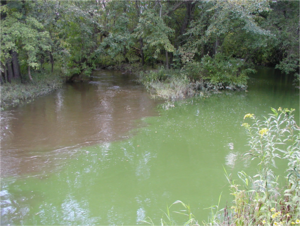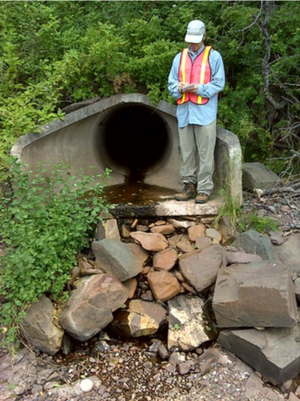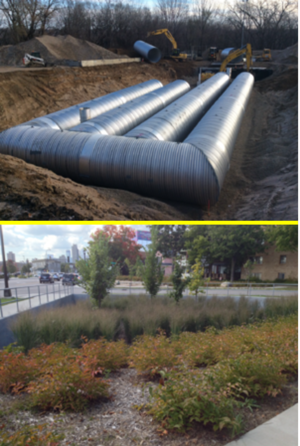
Recommendations and guidance for utilizing monitoring to meet TMDL permit requirements
Monitoring guidance presented below will assist Municipal Separate Storm Sewer System (MS4) permittees evaluate and demonstrate compliance with total suspended solid (TSS), total phosphorus (TP), bacteria, and chloride wasteload allocations (WLAs); and evaluate the impairment status of waterbodies and monitor the impact of total maximum daily load (TMDL) implementation strategies.
The guidance on this page provides specific recommendations related to four (4) monitoring strategies.
- Monitoring receiving waters: lakes
- Monitoring receiving waters: streams
- Monitoring major outfalls
- Monitoring BMPs
The four (4) monitoring strategies were selected based on input from and coordination with the Minnesota Pollution Control Agency (MPCA) and response of MS4 permittees to a voluntary survey conducted by the MPCA. Throughout this document, “MS4s” refers specifically to National Pollutant Discharge Elimination System (NPDES) regulated MS4s (i.e., Phase I and Phase II MS4s required to obtain NPDES permit coverage for their stormwater discharges).
The following table provides a summary of how each of the four (4) monitoring strategies can be used to evaluate WLA compliance and evaluate waterbody impairment status. Before adopting monitoring strategies discussed below, the applicable TMDL(s) and MS4 WLA(s) should be reviewed and compared to recommendations in the table below. Additionally, the applicable TMDL(s) should be reviewed to determine (a) if an ongoing water quality monitoring program is or will be implemented and (b) what organization(s) are responsible for water quality monitoring (e.g., individual MS4s, the applicable Watershed District or Watershed Management Organization (WMO), etc.).
Note: regardless of whether an ongoing monitoring program has been established, individual MS4s may independently monitor water quality to supplement data collected by other organizations to help track and evaluate impairment status, while employing proper quality assurance/quality control (QA/QC) methods for data collection and reporting.
MS4 TMDL compliance monitoring strategy summary
Link to this table
| Monitoring strategies | ||||
|---|---|---|---|---|
| MS4 TMDL Compliance Strategy | Monitoring receiving waters - lakes | Monitoring receiving waters - streams | Monitoring outfalls | Monitoring BMPs |
| Monitor improving water quality and delist from 303(d) Impaired Waters List | X | X | ||
| Upstream/downstream monitoring to identify “hot spots” (e.g., locations where intervening flow is causing impairment) | X | |||
| Evaluating compliance with MS4 wasteload allocation (WLA)… | ||||
| WLA in terms of mass reduction (e.g., lbs/year, org/day, etc.) | X | X | ||
| WLA in terms of percent reduction from baseline condition (e.g., 40% reduction) | X | X | ||
| WLA in terms of areal loading reduction (e.g., lbs/acre/year) | X | |||
Contents
Monitoring Survey
In 2018, the MPCA conducted a survey of MS4 permittees related to water quality modeling and water quality monitoring. Half of respondents (26 of 54) actively perform water quality monitoring or are otherwise involved in the collection of water quality monitoring data, with monitoring of receiving waters being the most commonly reported form of water quality monitoring. Responses from permittees were used to inform the selection of monitoring strategies and are summarized below.
Evaluating Impairment Status
A majority of TMDL Implementation Plans include recommendations related to ongoing monitoring of the impaired waterbody. Ongoing monitoring is critical to evaluating the impact of TMDL implementation strategies (e.g., BMP implementation) as they are enacted throughout the watershed. If ongoing monitoring shows that water quality has improved such that the water body is no longer impaired, that water body can be removed (i.e., delisted) from the 303(d) Impaired Waters List. Within the Guidance Manual for Assessing Quality of Minnesota Surface Waters for Determination of Impairment: 305(b) Report and 303(d) List (MPCA, 2018a), the MPCA has provided specific data and assessment requirements needed to consider removing a water body from the 303(d) Impaired Waters List. Requirements for the four (4) pollutants are included, below.
Note: specific guidance related to monitoring of receiving lakes and streams is found here. Additionally, the monitoring case studies provide examples of how TMDL implementation strategies and monitoring were used to delist two impaired waterbodies: Wirth Lake, originally listed for excess nutrient (i.e., TP) impairment, and Nine Mile Creek, originally listed for turbidity (i.e., TSS) impairment.
Total suspended solids (TSS) must have the following
- At least 20 observations (i.e., water quality samples) (pre- and post-corrective action) in the most recent 10 years, of which at least 10 observations (pre- and post-corrective action) are in the most recent 5 years; or
- At least 20 observations in the most recent 5 years, and evidence of corrective action (i.e., actions taken to improve water quality) in the watershed of sufficient dimension (i.e., sufficient load reduction to impact water quality in the receiving waterbody) to change impairment status. In either case, there must be fewer than 10% of samples exceeding the water quality standard.
Lake eutrophication (TP) must have the following
- At least 8 paired (i.e., collected at the same time) TP, corrected (i.e., corrected for pheophytin) chlorophyll a (chl-a), and Secchi disk measurements (June to September) over a minimum of 2 years for the most recent 10 years.
- If TP meets the standard, and either chl-a or Secchi meet the standard, the lake will be removed from the Impaired Waters List.
- If TP exceeds the standard and corrected chl-a AND Secchi meet the standard, and an improving trend in TP is observed or management activities are in place to maintain improved chl-a or Secchi observations, the lake may be delisted.
Delisting based on these criteria will be evaluated by the MPCA on a case-by-case basis, and will require the local entity to provide information that details how the response conditions will be met over time.
Stream eutrophication (TP) must have the following.
- Monitoring of the causative variable (i.e., TP) and the response variable(s) (i.e., chlorophyll-a, BOD5 (biological oxygen demand), pH, or diel DO (dissolved oxygen) flux) that were used to list the AUID (Assessment Unit identifier) meet the standard within the summer period (June 1 through September 30);
- A minimum of 12 paired samples over a minimum of 2 years of the causative and response variable(s);
- A minimum of 20 pH samples over a minimum of 2 years; and
- A minimum of 2 DO sonde deployments; each with a length of 4 days and occurring in separate years.
E. coli bacteria must have the following.
- A minimum of 15 observations over a two-year period in the most recent 10 years, with a minimum of 5 observations per month for at least 3 months when the standard is applicable (April – October).
- Impairment is evaluated by calculating the geometric mean of data collected within each month (April – October) since corrective actions were taken in the watershed of sufficient dimension to change impairment status.
- Note: if a sufficient number of observations have been aggregated within a 2-year time period since corrective actions were taken (i.e., 5 observations per month for 3 months, April – October), the most recent 2-year time period may be used to evaluate impairment.
- Note: a “month” can be defined as any non-overlapping 30-day period from April – October (i.e., “month” does not need to be defined by the individual calendar months from April – October).
- To change impairment status, there must be no exceedance of the monthly mean standard (126 organisms per liter) by the geometric mean of data collected within any month period when the standard applies (April – October). Additionally, no more than 10% of samples taken within any month period shall exceed the “maximum” standard (1,260 organisms per liter).
Chloride must have the following.
- At least 5 observations (pre and post-corrective action) for any 3-year interval in the most recent 10 years; or
- At least 5 observations for any 3-year interval in the most recent 5 years, and evidence of corrective action in the watershed of sufficient dimension to change impairment status.
- In either case, no more than one exceedance of the chronic water quality standard in any 3-year interval (note: the chronic standard is a 4-day average concentration).
The water quality standards referred to in the delisting criteria, above, are specific to the pollutant (e.g., TSS), the water body type (e.g., stream), and the water use classification (e.g., Class 2A). The TMDL report for the impaired waterbody is required to outline applicable water quality standards for all water(s) included within the report. Additionally, a complete list of all water quality standards applicable to Minnesota waters can be found in the Minnesota Rule, Chapter 7050 (MINN. R. 7050, 2018). As noted in the Guidance Manual for Assessing Quality of Minnesota Surface Waters for Determination of Impairment: 305(b) Report and 303(d) List (MPCA, 2018a), all delisting decisions are subject to review by the appropriate watershed assessment and professional judgment teams. Because the review team will consider watershed conditions and the representativeness of collected data, watershed improvement information should be summarized and presented to the review team. Special effort should be taken to ensure that collected data are representative of a wide range of watershed conditions (e.g., variability of flow conditions, seasonal variability, etc.).
Monitoring receiving waters
The primary reasons for a permittee to perform monitoring of receiving waters are to (a) evaluate the impact of TMDL implementation strategies enacted throughout the watershed, and (b) evaluate impairment status to determine if the impaired waterbody can be removed (i.e., delisted) from the 303(d) Impaired Waters List. The following subsections outline the basics of developing a monitoring program to meet goals established within the Guidance Manual for Assessing Quality of Minnesota Surface Waters for Determination of Impairment: 305(b) Report and 303(d) List (MPCA, 2018a), and developing a monitoring protocol standard operating procedure (SOP). Specifically, the Establishing a Monitoring Program section provides guidance on when, where, and what to sample, while the Establishing a Monitoring Protocol section provides guidance on how to sample (i.e., sampling SOP).
Establishing a Monitoring Program
Before developing or implementing a lake or stream monitoring program, the applicable TMDL(s) should be reviewed to determine (a) if an ongoing water quality monitoring program exists or will be implemented and (b) what organization(s) are responsible for water quality monitoring (e.g., individual permitteess, the applicable Watershed District or Watershed Management Organization (WMO), etc.). Review of ongoing and planned water quality monitoring programs can help a permittee optimize sampling procedures to supplement ongoing monitoring efforts and help identify potential partnering opportunities with other organizations (e.g., WDs, WMOs, Citizen-Assisted Monitoring Program (CAMP), Soil and Water Conservation Districts (SWCDs), Metropolitan Council, etc.). To encourage statewide water quality monitoring efforts, the MPCA offers Surface Water Assessment Grants (SWAG) to eligible partners, including MS4s. More information on SWAG requirements and grant application can be found on the MPCA’s Surface Water Assessment Grants webpage.
In addition to review of planned or ongoing monitoring programs, the applicable TMDL(s) should be reviewed to determine the specific water quality standard(s) that apply to the impaired waterbody. Water quality standards applicable to the impaired waterbody are specific to the pollutant (e.g., chloride), the water body type (e.g., lake), and the water use classification (e.g., Class 2A).
Monitoring requirements: lakes
The following subsections outline specific lake monitoring program requirements related to each of the four (4) pollutants discussed on this page: total suspended solids (TSS), total phosphorus (TP), bacteria, and chloride.
Total suspended solids (TSS)
As of 2018 Minnesota Impaired Waters List (MPCA, 2018b) there are no lakes listed as impaired for TSS. For more information regarding establishing a TSS monitoring program for streams, link here.
Eutrophication standard: lakes (TP, chlorophyll-a, and Secchi disk transparency)
Lake eutrophication water quality standards established in the Minnesota Rule, Chapter 7050 (MINN. R. 7050, 2018) require paired observations of TP, chlorophyll-a, and Secchi disk transparency during the summer period (June 1 through September 30) of the monitoring year. From Part 7050.0222, Subp. 2a:
Eutrophication standards for lakes and reservoirs are compared to summer-average data. Exceedance of the total phosphorus and either the chlorophyll-a or Secchi disk transparency standard is required to indicate a polluted condition.
The numeric standards for TP, chlorophyll-a, and Secchi disk transparency vary by use classification (e.g., Class 2B), ecoregion (e.g., North Central Hardwood Forests), and by lake classification (e.g., trout lake, shallow lake, etc.). The applicable water quality standards for the impaired waterbody are outlined in the applicable TMDL report. Based on Minnesota lake eutrophication standards and specific impairment assessment and delisting requirements for lake eutrophication, the following list outlines specific recommendations to develop a lake eutrophication monitoring program. Specific monitoring protocol recommendations are discussed here.
Lake Eutrophication Monitoring Program Recommendations
- Number of samples per year:
- Minimum: eight (8) paired samples of TP, chlorophyll-a, and Secchi disk over a minimum of a 2 year period within the most recent 10 years.
- Recommended: four (4) or more paired samples of TP, chlorophyll-a, and Secchi disk transparency collected between June 1 and September 30 per year on an ongoing basis to continually monitor and evaluate lake eutrophication. Sampling dates should be selected and fixed before the monitoring season to remove sampling bias in selected monitoring dates. Monitoring should, to the extent possible, be collected at equal intervals throughout the period of June 1 to September 30 (i.e., sampling should capture seasonal changes in water quality).
- Seasonal monitoring requirements: Samples must be collected between June 1 and September 30 of the sampling year.
- Sampling location(s): Selected sampling locations should be consistent with sampling locations used to originally define impairment. Sampling locations used to define impairment may be outlined within the applicable TMDL(s). If not, contact MPCA to determine sampling location used to define impairment.
- Sampling protocol (i.e., sample collection guidance): link here.
Bacteria (E. coli)
As of the 2018 Minnesota Impaired Waters List (MPCA, 2018b) there are no lakes listed as impaired for Escherichia coli (E. coli). For more information regarding establishing an E. coli monitoring program for streams, link here.
Chloride
Chloride water quality standards within Minnesota Rule, Chapter 7050 (MINN. R. 7050, 2018) are consistent for all Minnesota waters (i.e., all use classifications). Specifically, Minnesota Rules define a chronic toxicity-based chloride water quality standard of 230 mg/L (i.e., chronic standard), and an acute toxicity standard of 860 mg/L (i.e., maximum standard). Specific data requirements for evaluation of impairment condition for both the chronic and maximum chloride water quality standard established in the Guidance Manual for Assessing the Quality of Minnesota Surface Waters for Determination of Impairment: 305(b) Report and 303(d) List (MPAC, 2014) are outlined below.
- Chronic standard (230 mg/L):
- Exceedances of chronic standards for toxic pollutants are evaluated over a consecutive three year period.
- Two or more exceedances of the chronic standard in three years is considered an impairment.
- Chronic water quality standards are defined as a four (4) day average concentration. If concentrations in the waterbody are relatively stable, a single sample concentration value may be used to define the 4-day average. When concentrations are more variable, multiple samples or time-weighted composite samples are necessary to calculate an accurate average concentration.
- Maximum standard (860 mg/L):
- Exceedances of the maximum standards for toxic pollutants are evaluated over a consecutive three year period.
- One (1) exceedance of the maximum standard is considered an impairment.
The MPCA has published several Statewide Chloride Resources, including the Draft Statewide Chloride Management Plan (MPCA, 2019) and specific protocols related to stream and lake chloride monitoring.
Based on review of chloride standards, statewide guidance documents, and specific impairment assessment and delisting requirements for chloride impairment, the following list outlines specific recommendations for developing a lake chloride monitoring program. Specific monitoring protocol recommendations are discussed here.
Chloride Monitoring Program Recommendations
- Number of samples per year:
- Minimum: five (5) samples over any 3-year interval in the past 10 years.
- Recommended: five (5) samples per year for a 3-year interval. If chloride concentrations show high daily-variability (e.g., if daily concentrations vary by more than 30 mg/L), 4-day average sampling is required (i.e., five (5) separate 4-day average chloride concentrations should be used to evaluate chronic impairment).
- Depth monitoring recommendations:
- Recommended: for lakes more than 2 meters deep, samples should be collected at depths along the water column as described below because chloride concentration typically increases with depth. If 4-day averages are used, samples collected at each depth should be grouped and averaged together, rather than averaging all samples collected throughout the water column:
- Shallow: 0-2 meters;
- Deep: deepest 2 meters of the water column; and
- Mid-depth: midway between depths defined as “shallow” and “deep”.
- Recommended: for lakes more than 2 meters deep, samples should be collected at depths along the water column as described below because chloride concentration typically increases with depth. If 4-day averages are used, samples collected at each depth should be grouped and averaged together, rather than averaging all samples collected throughout the water column:
- Seasonal / critical period monitoring recommendations:
- Recommended: chloride concentration can vary significantly throughout the season due to critical chloride loading periods (e.g., winter deicing efforts). For this reason, the TMDL should be reviewed to determine if a critical period was identified (i.e., a seasonal period of most-elevated chloride concentrations). The following list provides examples of periods of elevated chloride concentration related to land use:
- January through May for lakes in urban areas and locations near deicing practices.
- April through November for lakes downstream of waste water treatment plant (WWTP) discharge locations.
- April through November for lakes downstream of heavy agriculture, near tile drainage systems, and/or proximal to gravel roadways that receive dust management.
- Recommended: chloride concentration can vary significantly throughout the season due to critical chloride loading periods (e.g., winter deicing efforts). For this reason, the TMDL should be reviewed to determine if a critical period was identified (i.e., a seasonal period of most-elevated chloride concentrations). The following list provides examples of periods of elevated chloride concentration related to land use:
- Sampling location(s): Selected sampling locations should be consistent with sampling locations used to originally define impairment. Sampling locations used to define impairment may be outlined within the applicable TMDL(s). If not, contact MPCA to determine sampling location used to define impairment.
- Miscellaneous recommendations: conduct paired conductivity (i.e., specific conductance) measurements during chloride monitoring. In some cases, a waterbody-specific chloride-conductivity relationship can be established. In these cases, conductivity can serve as a surrogate for chloride (as monitoring conductance is faster and cheaper than monitoring chloride directly). Review the TMDL report to determine if a waterbody-specific chloride-conductivity relationship has been established
- Sampling protocol (i.e., sample collection guidance): link here
Monitoring requirements: streams
The following subsections outline specific stream monitoring program requirements related to each of the four (4) pollutants discussed on this page: total suspended solids (TSS), total phosphorus (TP), bacteria, and chloride.
Total suspended solids (TSS)
Based on review of TSS water quality standards within the Minnesota Rule, Chapter 7050 (MINN. R. 7050, 2018), for many use classifications (e.g., Class 2A) and ecoregions (e.g., North River Nutrient Region), TSS standards are structured as follows.
TSS standards for [use classification, e.g., Class 2A] may be exceeded for no more than ten percent of the time. This standard applies April 1 through September 30.
The above standard, which supersedes the previous standard for turbidity, is the most common form of TSS standard within the Minnesota Rules (MINN. R. 7050, 2018), but the TSS standard may vary based on the use classification and ecoregion (e.g., Lower Mississippi River mainstem TSS standards are based on 50 percent exceedance from June 1 through September 30). For this reason, it is critical to review the applicable TMDL(s) to determine what water quality standard(s) apply to the impaired waterbody. Based on the most-common form of TSS standard and specific impairment assessment and delisting requirements for TSS, the following list outlines specific recommendations related to the development of a stream TSS monitoring program. Link here to specific monitoring protocol recommendations.
TSS Monitoring Program Recommendations
- Number of samples per year:
- Minimum: twenty (20) observations in the most recent 10 years, and at least 10 in the last 5 years.
- Recommended: at least five (5) samples collected per year between April 1 and September 30. Sampling dates should be selected and fixed before the monitoring season to remove sampling bias in selected monitoring dates. Monitoring should, to the extent possible, be collected at intervals throughout the period of April 1 to September 30 (i.e., sampling should capture seasonal changes in water quality).
- Seasonal monitoring recommendations: Samples must be collected between April 1 and September 30 of the sampling year unless the applicable water quality standard specifies a different period for standard compliance (e.g., TSS standards based on summer average values must be collected between June 1 and September 30 of the monitoring year).
- Flow monitoring recommendations: because TSS concentrations can vary based on flow rate, monitoring should ideally reflect a variety of flow conditions. For this reason, dry-weather monitoring, post-rainfall sampling, and seasonal sampling should be considered to ensure a variety of flow rates are captured in the TSS monitoring dataset.
- Sampling location(s): Selected sampling locations should be consistent with sampling locations used to originally define impairment. Sampling locations used to define impairment may be outlined within the applicable TMDL(s). If not, contact MPCA to determine sampling locations used to define impairment.
- Sampling protocol (i.e., sample collection guidance): link here
Eutrophication standard: streams (TP, chlorophyll-a, and Secchi disk transparency)
Stream eutrophication water quality standards established in Minnesota Rule, Chapter 7050 (MINN. R. 7050, 2018) require paired observations of TP, chlorophyll-a, five-day biological oxygen demand (BOD5) and diel dissolved oxygen (DO) flux. From Part 7050.0222, Subp. 3b:
Eutrophication standards for rivers, streams, and navigational pools are compared to summer-average data or as specified in subpart 3. Exceedance of the total phosphorus levels and chlorophyll-a (seston), five-day biochemical oxygen demand (BOD5), diel dissolved oxygen flux, or pH levels is required to indicate a polluted condition.
The standard requires paired observations of TP, chlorophyll-a, BOD5, and diel DO flux during the summer period (June 1 through September 30) of the monitoring year. As outlined in Part 7050.0222, Subp. 3, standards for each of the four (4) parameters used to evaluate stream eutrophication vary by use classification (e.g., Class 2B) and ecoregion (e.g., North Central Hardwood Forests). The applicable water quality standards for the impaired waterbody will be outlined in the applicable TMDL report.
Based on Minnesota stream eutrophication standards and specific impairment assessment and delisting requirements for stream eutrophication, the following list outlines specific recommendations related to the development of a stream eutrophication monitoring program. Link here for specific monitoring protocol recommendations.
Stream Eutrophication Monitoring Program Recommendations
- Monitored parameters:
- Minimum: total phosphorus (TP) and the response variable(s) that were originally used to define stream impairment.
- Recommended: total phosphorus (TP) and all stream eutrophication response variables: chlorophyll-a, BOD5, diel DO flux, and pH.
- Number of samples:
- Minimum: twelve (12) paired samples over a minimum of 2 years for TP, chlorophyll-a, and BOD5 twenty (20) samples of pH over a minimum of 2 years, and two (2) four-day DO sonde deployments to evaluate diel DO flux.
- Recommended: twenty (20) paired samples of TP, chlorophyll-a, and BOD5 per year during the summer period of June 1 through September 30 (i.e., 5 per month), twenty (20) samples of pH over a minimum of 2 years during the summery period, and two (2) four-day DO sonde deployments per year during the summer period.
- Seasonal monitoring requirements: Samples must be collected during the summer period (June 1 and September 30) of the sampling year.
- Sampling location(s): Selected sampling locations should be consistent with sampling locations used to originally define impairment. Sampling locations used to define impairment may be outlined within the applicable TMDL(s). If not, contact MPCA to determine sampling location(s) used to define impairment.
- Sampling protocol (i.e., sample collection guidance): link here
Bacteria (E. coli)
Based on review of bacteria (E. coli) water quality standards within Minnesota Rule, Chapter 7050 (MINN. R. 7050, 2018), for many use classifications (e.g., Class 2A) and ecoregions (e.g., North River Nutrient Region), E. coli standards are structured as follows.
From Part 7050.0222, Subp. 2 (Class 2A): “Escherichia (E.) coli bacteria shall not exceed 126 organisms per 100 milliliters as a geometric mean of not less than five samples representative of conditions within any calendar month, nor shall more than ten percent of all samples taken during any calendar month individually exceed 1,260 organisms per 100 milliliters. The standard applies only between April 1 and October 31.
The above standard, which supersedes the previous standard for fecal coliform bacteria, is the most common form of E. coli standard in Minnesota Rules (MINN. R. 7050, 2018), but the E. coli standard may vary based on the use classification (e.g., for Class 3C water bodies, the geometric mean standard is 630 organisms per 100 milliliters, rather than 126). For this reason, it is critical to review the applicable TMDL(s) to determine what water quality standard(s) apply to the impaired waterbody.
Based on the most-common form of E. coli standard and specific impairment assessment and delisting requirements for E. coli, the following list outlines specific recommendations related to the development of a stream E. coli monitoring program. Link here for specific monitoring protocol recommendations.
Bacteria (E. coli) Monitoring Program Recommendations
- Number of samples per year:
- Minimum: fifteen (15) samples over a two-year period in the last 10 years, with a minimum of five (5) samples per month for at least 3 months where the standard applies (i.e., April-October).
- Recommended: five (5) samples per month for the period of April-October (i.e., 35 samples per year), or five (5) samples per month for the critical period of June-September (i.e., 20 samples per year).
- Seasonal monitoring recommendations: The standard applies for the period of April 1 to October 31.
- Flow monitoring recommendations: Recommended: because E. coli concentrations can vary based on flow rate, monitoring should ideally reflect a variety of flow conditions. For this reason, dry-weather monitoring, post-rainfall sampling and seasonal sampling should be considered to ensure a variety of flow rates are captured in the bacteria monitoring dataset.
- Sampling location(s): Selected sampling locations should be consistent with sampling locations used to originally define impairment. Sampling locations used to define impairment may be outlined within the applicable TMDL(s). If not, contact MPCA to determine sampling location used to define impairment.
- Sampling protocol (i.e., sample collection guidance): link here
Chloride
Chloride water quality standards within the Minnesota Rule, Chapter 7050 (MINN. R. 7050, 2018) are consistent for all Minnesota waters (i.e., all use classifications). Specifically, Minnesota Rules define a chronic toxicity-based chloride water quality standard of 230 mg/L (i.e., chronic standard), and an acute toxicity standard of 860 mg/L (i.e., maximum standard). Specific data requirements for evaluation of impairment condition for both the chronic and maximum chloride water quality standard established in the Guidance Manual for Assessing the Quality of Minnesota Surface Waters for Determination of Impairment: 305(b) Report and 303(d) List (MPCA, 2014) are outlined, below.
- Chronic standard (230 mg/L):
- Exceedances of chronic standards for toxic pollutants are evaluated over a consecutive three year period.
- Two or more exceedances of the chronic standard in three years is considered an impairment.
- Chronic water quality standards are defined as a four day (4-day) average concentration. If concentrations in the waterbody are relatively constant, a single sample concentration value may be used to define the 4-day average. When concentrations are more variable, multiple samples or time-weighted composite samples are necessary to calculate an accurate average concentration.
- Maximum standard (860 mg/L):
- Exceedances of the maximum standards for toxic pollutants are evaluated over a consecutive three year period.
- One (1) exceedance of the maximum standard is considered an impairment.
The MPCA has published several Statewide Chloride Resources, including the Draft Statewide Chloride Management Plan (MPCA, 2019) and specific protocols related to stream and lake chloride monitoring.
Based on review of chloride standards, statewide guidance documents, and specific impairment assessment and delisting requirements for chloride impairment, the following list outlines specific recommendations for developing a stream chloride monitoring program. Specific monitoring protocol recommendations are discussed here.
Chloride Monitoring Program Recommendations
- Number of samples per year:
- Minimum: five (5) samples over any 3-year interval in the past 10-years.
- Recommended: five (5) samples per year for a 3-year interval. If chloride concentration show high daily-variability, 4-day average sampling is required (i.e., five (5) separate 4-day average chloride concentrations should be used to evaluate chronic impairment).
- Location and depth of monitoring: Recommended: samples should be taken mid-stream, mid-depth whenever possible.
- Monitoring and flow rate: Recommended: because chloride concentrations can vary based on flow rate, monitoring should ideally reflect a variety of flow conditions. For this reason, dry-weather monitoring, post-rainfall sampling, and seasonal sampling should be considered to ensure a variety of flow rates are captured in the chloride monitoring dataset.
- Seasonal / critical period monitoring requirements:
- Recommended: chloride concentration can vary significantly throughout the season due to critical chloride loading periods (e.g., winter deicing efforts). For this reason, the TMDL should be reviewed to determine if a critical period was identified (i.e., a seasonal period of most-elevated chloride concentrations). The following list provides examples of periods of elevated chloride concentration related to land use:
- December through April for streams in urban areas and locations near deicing practices.
- April through November for streams downstream of waste water treatment plant (WWTP) discharge locations.
- April through November for streams downstream of heavy agriculture, near tile drainage systems, and/or proximal to gravel roadways that receive dust management.
- Recommended: chloride concentration can vary significantly throughout the season due to critical chloride loading periods (e.g., winter deicing efforts). For this reason, the TMDL should be reviewed to determine if a critical period was identified (i.e., a seasonal period of most-elevated chloride concentrations). The following list provides examples of periods of elevated chloride concentration related to land use:
- Note: streams dominated by baseflow (i.e., groundwater flow) may show elevated chloride concentrations at periods other than those listed above.
- Sampling location(s):
- Selected sampling locations should be consistent with sampling locations used to originally define impairment. Sampling locations used to define impairment may be outlined within the applicable TMDL(s). If not, contact MPCA to determine sampling location(s) used to define impairment.
- Note: if there are multiple monitoring locations along the reach, all samples collected at a given depth (see definition of “shallow”, “deep”, and “mid-depth”, above) are combined for the 4-day average calculation.
- Miscellaneous recommendations: **Recommended: conduct paired conductivity (i.e., specific conductance) measurements during chloride monitoring. In some cases, a waterbody-specific chloride-conductivity relationship can be established. In these cases, conductivity can serve as a surrogate for chloride (as monitoring conductance is faster and cheaper than monitoring chloride directly). Review the TMDL to determine if a waterbody-specific chloride-conductivity relationship has been established
- Sampling protocol (i.e., sample collection guidance): link here
Establishing a Monitoring Protocol
The MPCA has specific requirements and protocols related to water quality data collection, laboratory processing of water quality samples, data processing of laboratory results, and final submittal of water quality data to the MPCA for review. Specifically, the MPCA uses a data processing system called EQuIS (Environmental Quality Information System) to store and process water quality data collected from over 17,000 sampling locations across the state, and requires that data be collected and processed in a manner which is compatible with EQuIS.
There are many publicly available Quality Assurance Project Plan (QAPP) and monitoring Standard Operating Procedure (SOP) documents which can be used as a framework for developing a monitoring protocol. The following subsections provide an overview of EQuIS requirements and a summary of lake and stream monitoring QAPP and SOP documents.
EQuIS
The MPCA has developed extensive guidance related to establishing EQuIS projects, and developed tools and guidance to assist monitoring and laboratory staff to process data in an EQuIS-compatible format. The following steps provide a basic overview of the EQuIS data collection and submittal process: establishing an EQuIS project, processing collected water quality data, and submitting collected data to the MPCA for review. Collecting, processing, and submitting EQuIS data requires contact and coordination with an MPCA EQuIS team member.
- Coordinate with an MPCA EQuIS team member and establish an EQuIS project (i.e., submit the EQuIS Project Establishment Form).
- Submit a location establishment form.
- Collect water quality data and submit to a State-certified laboratory.
- Procedures to collect water quality samples and submit to a certified laboratory, including pre- and post-monitoring protocols, quality assurance and quality control ( QA/QC), and guidance regarding chain of custody (COC) preparation and documentation are discussed below.
- The MPCA EQuIS team member can be contacted regarding State-certified laboratories.
- Submit EQuIS formatted data to the MPCA for review.
- The EQuIS Data Gathering Engine (EDGE) can be used to generate EQuIS formatted data during field data collection.
- The Lab_MN lab data storage spreadsheet can be used by certified labs to generate EQuIS formatted data of laboratory results.
- If not using EDGE or Lab_MN, data can be manually formatted into the Surface Water Data Template.
Monitoring Quality Assurance Program Plan (QAPP)
The primary objective of a QAPP is to define the data quality assurance (QA) goals and procedures applicable to a monitoring program (MCES, 2003). A lake or stream monitoring QAPP must also provide an overview of program design (e.g., program organization, responsibilities, monitoring parameters, sampling locations, etc.), and must define sampling methods (e.g., sampling locations and monitored variables), analytical procedures, QA procedures, and data review protocols.
For this reason, a QAPP document may also contains monitoring SOP(s), defining sampling procedures, field analysis, laboratory analysis, and data review and QAQC measures.
The following subsections provide a summary of monitoring QAPP documents which can be used as templates for developing a lake or stream monitoring QAPP.
MCES Stream Monitoring QAPP
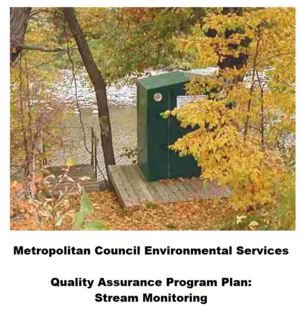
The MCES Quality Assurance Program Plan: Stream Monitoring (MCES, 2003; updated 2011) is a QAPP for the MCES’s Nonpoint Source Pollution Monitoring Program and Watershed Outlet Monitoring Program (WOMP). The QAPP defines goals, objectives, program organization, responsible parties, specific sampling procedures and protocols (e.g. monitoring SOPs, QA procedures, laboratory analytical procedures, etc.), and the monitoring locations, monitored variables, and monitoring frequency for both stream monitoring programs. Specifically, the QAPP is organized into the following sections:
- Introduction: defines the background and purpose of the QAPP, as well as the relationship of the QAPP to other guidance documents (specifically, the monitoring SOPs included as appendices).
- Program Organization and Responsibility: defines the organization of the QAPP, responsible parties, and defines roles and responsibilities for positions and individual staff members.
- Monitoring Program Description: defines the study area, specific monitoring locations, monitored variables (e.g., Total Phosphorus, CBOD 5-day, etc.), and monitoring frequency.
- Quality Assurance Objectives: defines QA objectives related to precision, accuracy, representativeness, completeness, comparability, and analytical sensitivity.
- Sampling Methods: defines procedures and protocols for two forms of sampling: instantaneous grab sampling and flow-weighted composite sampling. Provides and overview of sampling procedures, field equipment, and bottle preparation, etc. and refers reader to the field sampling SOPs included in the QAPP appendices.
- Field and Sample Custody Documentation: defines the field and sample documentation requirements for the MCES stream monitoring programs. Field documentation (e.g., field conditions, time, weather conditions, deviation from written procedures, standardized field documentation sheets) and laboratory chain-of-custody are critical for interpreting results and identifying erroneous samples (e.g., mislabeled samples).
- Field Measurement Procedures: defines field monitoring equipment (e.g., specific models of in situ monitoring equipment), monitoring station layout, maintenance, and operations, and a description of all monitoring parameters. More details related to field procedures are included in the monitoring SOPs included in the QAPP appendices.
- Laboratory Analytical Procedures: defines the laboratory analytical method for each monitored variable and identifies the State-certified laboratory used for sample processing and analysis. Additional information relate to laboratory procedures, processes, and QA program are included in the laboratory QA manual included in the QAPP appendices.
- Quality Assurance Procedures: defines QA procedures relate to data review and validation, QA audits and reporting, and corrective action strategies.
- Data Reporting: defines reporting protocols related to automate electronic data reporting and annual assessment reporting.
The organization of the MCES Stream Monitoring QAPP can be used as template for the development of a stream or lake monitoring QAPP. In addition to defining the organization, goals, and QA procedures for the monitoring programs, the QAPP also includes sampling, field analysis, laboratory analysis, and data review SOPs as appendices to the document. The SOPs outline specific monitoring procedures to be followed in the field (e.g., equipment checklist, grab sample bottle and equipment cleaning, field duplicate collection and labeling, health and safety procedures, etc.). Monitoring SOPs are discussed in more detail below.
Other Monitoring QAPP Resources
The MPCA and United States Environmental Protection Agency (USEPA) have developed many guidance documents related to QA and the development of QAPPs. Specific QAPP guidance documents and QA tools are summarized below:
- MPCA Quality System: aggregated resources related to QA of environmental data. Includes many QAPP development documents and examples of completed QAPPs. Additionally, includes documents related to the development of SOPs, example SOPs (e.g., lake monitoring SOP), and State-certified laboratory guidance and reference documents.
- MPCA QA Project Plan Guidance: guidance document for developing MPCA Remediation Program QAPPs.
- EPA QAPP Development Tool: web-based QAPP development tool. The tool provides step-by-step guidance related to developing a surface water monitoring QAPP, and is partitioned into the following six (6) modules:
- Module 1 – guidance on preparing a QAPP.
- Module 2 – QAPP template.
- Module 3 – Model QAPP: provides and model example of a completed QAPP.
- Module 4 – references and links for technical and QA information to assist in developing a QAPP.
- Module 5 – standard operating procedures (SOPs): contains development guidance and example SOPs related to surface water monitoring.
- Module 6 – selecting an environmental laboratory: provides guidance related to selecting a State-certified laboratory for sample processing.
- EPA Requirements for QAPPs: defines EPA QAPP requirements.
Questions related to QAPP development, QA procedures, or the references listed above can be directed to any of the MPCA QA coordinators listed in the “Contacts” section of the MPCA Quality System webpage.
Monitoring Standard Operation Procedure (SOP)
As discussed above, a monitoring standard operating procedure (SOP) is a critical component of a complete monitoring QAPP. A monitoring SOP defines specific protocols related to field sample collection and laboratory analysis, and often also includes pre-field protocols (e.g., equipment and supply checklist, pre-field bottle preparation and labeling, etc.), post-sampling protocols (e.g., sample preparation and preservation, sample chain of custody, etc.) and other protocols not specifically related to monitoring and sample collection (e.g., boat and canoe preparation, health and safety, inclement weather protocols, etc.).
The following subsections provide a summary of monitoring SOP documents which can be used as templates for developing a lake or stream monitoring SOP. It is recommended that the documents discussed in this section be used in conjunction with specific monitoring guidance outlined in the applicable TMDL when developing a lake or stream monitoring SOP.
NOTE: See example case studies in which monitoring was used to help identify pollutant sources, evaluate the impact of implementation strategies, and ultimately delist a formerly-impaired water body.
MPCA Lake and Stream Water Quality Sampling SOPs
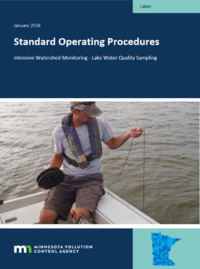
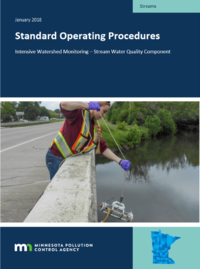
The Standard Operating Procedures: Intensive Watershed Monitoring – Lake Water Quality Sampling (MPCA, 2018c) and Standard Operation Procedures: Intensive Watershed Monitoring – Stream Water Quality Component (MPCA, 2018d) are SOPs created by the MPCA for local partners contracted through the MPCA’s Surface Water Assessment Grants Program. The SOP outlines sampling procedures applicable to all Minnesota lakes and streams, including pre-sampling requirements, equipment and supply checklists, on-site sampling procedures, QAQC procedures (e.g., field sample duplicates), post-sampling procedures, and a detailed discussion of health and safety protocols. In addition to pre- and post-sampling procedures, the SOP discusses bottle labeling and the chain of custody (COC) procedures for delivering samples to State-certified laboratories, and final data preparation and submittal to EQuIS.
Other Monitoring SOP Resources
The MPCA, USEPA, and MCES have developed many publically available guidance documents related to the development of surface water monitoring SOPs. Specific SOP documents which be used as templates to develop a surface water monitoring SOP are summarized below. It is recommended that the documents discussed in this section be used in conjunction with specific monitoring guidance outlined in the applicable TMDL when developing a lake or stream monitoring SOP:
- Chloride Monitoring Guidance for Lakes (MPCA, 2015a) and Chloride Monitoring Guidance for Streams and Stormsewers (MPCA, 2015b): these documents are similar in scope to the MPCA lake and stream monitoring SOPs (MPCA, 2018c; MPCA, 2018d), but include specific guidance related to monitoring chloride, including a detailed winter monitoring SOP. Winter monitoring guidance includes a detailed description of how to predict and monitor winter thaw and rain events, which often produce elevated chloride concentration in streams due to mobilization of deicing salts accumulated over winter deicing operations.
- MCES Quality Assurance Program Plan: Stream Monitoring (MCES, 2003; updated 2011): the stream monitoring QAPP contains sampling, field analysis, laboratory analysis, and data review SOPs as appendices.
- EPA QAPP Development Tool: Module 5 of the web-based tool contains development guidance and example SOPs related to surface water monitoring. SOP documents can requested from the EPA via the EPA contact listed in Module 5.
Questions related to SOP development can be directed to any of the MPCA QA coordinators listed in the “Contacts” section of the MPCA Quality System webpage.
Monitoring major outfalls
The primary reasons for an MS4 to monitor water quality at major storm sewer outfalls (i.e., major outfalls) are to (a) evaluate compliance with MS4 wasteload allocations (WLAs) established in applicable TMDLs, and (b) evaluate compliance with water quality standards established in Minnesota Rule, Chapter 7050 (MINN. R. 7050, 2018). Demonstrating compliance with established WLAs or applicable water quality standards are two methods by which an MS4 can demonstrate it is meeting pollutant loading goals established within the applicable TMDL.
Note: established WLAs should be reviewed before attempting to evaluate compliance with applicable water quality standards, as the water quality standard applicable to the receiving water body may not be reasonably achieved at a stormsewer outfall. In these situations, the MS4 should evaluate compliance with the established WLA.
The following subsections outline the basics of developing an outfall monitoring program to meet goals established within the Guidance Manual for Assessing Quality of Minnesota Surface Waters for Determination of Impairment: 305(b) Report and 303(d) List (MPCA, 2018a), evaluating compliance with WLAs established in applicable TMDLs, and developing an outfall monitoring protocol standard operating procedure (SOP). Specifically, the Establishing a Monitoring Program section provides guidance on when, where, and what to sample, while the Establishing a Monitoring Protocol section provides guidance on how to sample (i.e., sampling SOP).
Establishing a Monitoring Program
Before developing or implementing an outfall monitoring program, the applicable TMDL(s) should be reviewed to determine (a) if an ongoing water quality monitoring program is or will be implemented and (b) what organization(s) are responsible for water quality monitoring (e.g., individual MS4s, the applicable Watershed District or Watershed Management Organization (WMO), etc.). Review of ongoing and planned water quality monitoring programs can help an individual MS4 permittee optimize sampling procedures to supplement ongoing monitoring efforts, and can help individual MS4 permittees identify potential partnering opportunities with other organizations (e.g., WDs, WMOs, Citizen-Assisted Monitoring Program (CAMP), Soil and Water Conservation Districts (SWCDs), Metropolitan Council, etc.).
In addition to review of planned or ongoing monitoring programs, the applicable TMDL(s) and drainage areas to major outfalls within the MS4 should be reviewed to determine the following information:
- TMDL review:
- What portion of the MS4 is included in the TMDL (Note: TMDL subwatersheds may be obtained from the MPCA)? The entire municipal boundary? A fraction of the MS4 area?
- How is the MS4 wasteload allocation (WLA) structured (e.g. required pounds of reduction per year (lbs/yr); required areal loading rate (lbs/acre/year); etc.)?
- MS4 outfall and drainage area review:
- Is stormwater from the MS4 collected into major outfalls (i.e., outfalls which drain a large area and can be monitored), or are there many small, diffuse outfalls throughout the MS4 area?
- What portion of the TMDL watershed area drains to major outfalls?
- What is the total drainage area to major outfalls? Do drainage areas to major outfalls include area from other, neighboring MS4s?
- Water quality standard review:
- What water quality standard(s) (MINN. R. 7050, 2018) apply to the impaired waterbody?
The steps outlined in the following subsections can be used to determine if outlet monitoring is a viable strategy to demonstrate WLA compliance, and, if so, how to develop a monitoring program to evaluate WLA compliance.
Outfall monitoring feasibility
A critical first step to developing an outfall monitoring program is to evaluate the feasibility of outfall monitoring for evaluating WLA compliance. A detailed review of drainage areas to major outfalls should be conducted and compared to the impaired waterbody drainage area established in the TMDL.
Note: if the TMDL drainage area is not adequately outlined within TMDL documentation, TMDL drainage area documentation can be requested directly from the MPCA.
The following criteria can be used to determine if an MS4 is a good candidate for an outfall monitoring program:
- Good candidate for outfall monitoring:
- MS4 storm sewer is consolidated into a small number of large outfalls.
- Drainage areas to large outfalls coincide well with the TMDL watershed area.
- Outfalls are easily accessible for monitoring and data analysis.
- Sufficient staff and resources (e.g., time, equipment, etc.) to conduct outflow monitoring.
- Poor candidate for outfall monitoring:
- MS4 storm sewer discharges to a large number of small outfalls.
- Significant portions of the MS4 discharge via overland runoff (i.e., significant portions of the MS4 are not tributary to outfalls).
- Outfalls are difficult or dangerous to access.
- Insufficient staff and resources to conduct outflow monitoring.
If outfall monitoring is not feasible, monitoring receiving waters or monitoring BMPs may be used by MS4s to evaluate WLA compliance and impairment status of receiving waters. If outfall monitoring is feasible, this section provides monitoring program recommendations for evaluating compliance with areal loading WLAs (e.g., pounds of TSS per acre per year (lbs/acre/year) and this section provides recommendations for evaluating compliance with water quality standards applicable to the impaired receiving water.
Areal loading rate
Recommendations for outfall monitoring program development depend on how MS4 WLAs are established in the applicable TMDL(s). Outfall monitoring can be used to directly evaluate WLAs that are developed as a required areal loading rate (e.g., pounds of TSS loading per acre per year (lbs/acre/year)). The following list outlines specific outfall monitoring program recommendations to evaluate compliance with areal loading rate WLAs. Specific monitoring protocol recommendations are discussed here. Outfall Monitoring Program Recommendations for Evaluating Areal Loading Rate:
- Monitored area:
- Monitor all major outlets discharging to the impaired waterbody (see feasibility discussion above).
- Calculate the total drainage area (acres) to each monitored outlet within the TMDL watershed area. These areas will be used to calculate the areal loading rate at each monitoring location.
- Monitored parameters:
- Minimum: flow rate (e.g., using depth-velocity monitoring) and the pollutant for which the WLA areal loading rate was developed (e.g., TP).
- Recommended: flow rate, the pollutant for which the WLA areal loading rate was developed (e.g., TP), and any associated response variables used to define impairment (e.g., chlorophyll-a, BOD5, etc.).
- Monitoring period:
- Minimum: the seasonal duration used to define impairment for the given pollutant (e.g., April 1 through September 30 for TSS).
- Recommended: year-round monitoring if sufficient baseflow to prevent freezing conditions at monitoring location. If freezing occurs at monitoring station, monitor April through November.
- Sampling protocol:
- Continual monitoring using continuous flow loggers and automated or in situ sampling is required to accurately evaluate areal loading rate (see discussion here).
Compliance with water quality standards
Outfall monitoring can be used to directly evaluate compliance with areal loading rate WLAs, but is less suited to evaluating WLAs if the form of annual loading (e.g., lbs/yr, lbs/day), required annual reduction (lbs/yr), and required percent reduction from baseline conditions. This is because (a) it is unlikely the outfall watershed(s) will match exactly to the MS4 watershed area established in the TMDL, complicating the comparison of outfall loading to WLA annual loading established in the TMDL, and (b) outlet monitoring alone cannot be used to determine pollutant reduction achieved by BMPs within the watershed (see section on monitoring BMPs).
For this reason, rather than using outfall monitoring to directly evaluate WLA compliance, MS4s with non-areal loading rate based WLAs (e.g., annual loading, annual load reduction, etc.), can instead use outfall monitoring to evaluate compliance with water quality standards applicable to the impaired waterbody. Demonstrating that outflow from the MS4 is compliant with water quality standards applicable to the impaired waterbody demonstrates that the MS4 is not contributing to impairment. The following list outlines specific recommendations for the development of an outfall monitoring program to evaluate compliance with applicable water quality standards. Specific monitoring protocol recommendations are discussed here.
- Monitored area:
- Monitor all major outlets discharging to the impaired waterbody (see feasibility discussion).
- Number of samples per year, seasonal monitoring recommendations, and monitored parameters:
- For outfalls tributary to impaired lakes, see specific monitoring guidance related to each pollutant (TSS, TP, Bacteria, and Chloride).
- For outfalls tributary to impaired streams, see specific monitoring guidance related to each pollutant (TSS, TP, bacteria, and chloride).
- Sampling protocol: Discrete, event-based monitoring based on impairment determination requirements for each pollutant (link here for impaired lakes and here for impaired streams).
Establishing a Monitoring Protocol
The MPCA has specific requirements and protocols related to water quality data collection, laboratory processing of water quality samples, data processing of laboratory results, and final submittal of water quality data to the MPCA for review. Specifically, the MPCA uses a data processing system called EQuIS (Environmental Quality Information System) to store and process water quality data collected from over 17,000 sampling locations across the state, and requires that data be collected and processed in a manner which is compatible with EQuIS. A detailed description of the EQuIS system, including preparation of field monitoring results for submittal to the MCPA is presented here.
Although the MPCA has not developed SOP guidance specifically related to performing storm sewer outlet monitoring, much of the guidance in the Standard Operation Procedures: Intensive Watershed Monitoring – Stream Water Quality Component (MPCA, 2018d) is directly applicable to sampling from large storm sewer outfalls.
In addition to the general stream monitoring SOP (MPCA, 2018d), two additional outfall monitoring guidance documents are discussed, below: the Capitol Region Watershed District (CRWD) 2015 Stormwater Monitoring Report (CRWD, 2015) and the University of Minnesota (UMN) Optimizing Stormwater Treatment Practices (Erickson et al, 2013). These documents provide specific guidance related to outfall monitoring and outfall monitoring equipment, including automated sampling techniques and equipment, but do not provide detailed SOP instructions (e.g., pre-sampling requirements, equipment and supply checklists, on-site sampling procedures, health and safety protocols, etc.), which should supplement the general stream monitoring SOP (MPCA, 2018d).
It is recommended that the documents reference herein be used in conjunction with specific monitoring guidance outlined in the applicable TMDL when developing an outfall monitoring SOP. The following subsection provides an example of how outfall monitoring can be used to evaluate compliance with an areal loading rate WLA.
Click here to link to a case study.
Additional Resources
- CRWD 2015 Stormwater Monitoring Report (CRWD, 2015): this document provides a detailed summary of outlet monitoring performed throughout the watershed district in 2015. The document describes how the CRWD established an outflow monitoring network, and highlights how continuously monitoring “full water quality stations” were established using area-velocity flow sensors and automated water samplers. Additionally, the document discusses monitoring QAQC procedures and describes data processing and algorithms used to partition flows (i.e., separate baseflow from event flow), calculate event pollutant loading, baseflow pollutant loading, flow-weighted average concentration calculations, and pollutant areal yield (lbs/acre).
- Optimizing Stormwater Treatment Practices (Erickson et al, 2013): this document provides detailed information on water quality sampling approaches (discrete sampling, composite sampling, manual, time-weighted, and flow-weighted sampling), and information on “continuous” flow sampling with automated samplers and in situ monitoring equipment (i.e., monitoring probes capable of monitoring pollutants in real time).
Monitoring BMPs
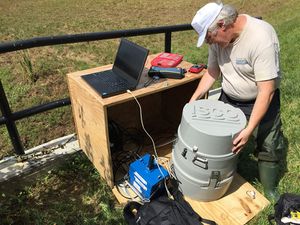
Although BMP monitoring often refers to routine BMP infrastructure inspection and maintenance, in the context of this technical memorandum, BMP monitoring refers to monitoring flow volumes and pollutant loading into and out of an individual BMP to evaluate pollutant reduction effectiveness. Although performance of individual BMPs is typically estimated through modeling, calculated from design standards, or estimated using published literature values, MS4s may choose to monitor individual BMPs to more accurately evaluate BMP performance and track progress towards achieving target WLA reduction goals. Due to the cost and difficulty of individual BMP monitoring, BMP monitoring is typically considered only for large, regional BMPs where accurate calculation of BMP performance is critical to evaluating progress towards WLA reduction targets.
The following subsections outline the basics of developing a monitoring program for evaluating individual BMP performance and developing a monitoring protocol SOP. Specifically, the Establishing a Monitoring Program section provides guidance on when, where, and what to sample, while the Establishing a Monitoring Protocol section provides guidance on how to sample (i.e., sampling SOP).
Establishing a Monitoring Program
Before developing or implementing a BMP monitoring program, the applicable TMDL(s) should be reviewed to determine (a) if an ongoing water quality monitoring program is or will be implemented and (b) what organization(s) are responsible for water quality monitoring (e.g., individual MS4s, the applicable WMO, etc.). Review of ongoing and planned water quality monitoring programs can help an individual MS4 optimize sampling procedures to supplement ongoing monitoring efforts, and can help individual MS4s identify potential partnering opportunities with other organizations (e.g., WDs, WMOs, Universities, etc.).
In addition to review of planned or ongoing monitoring programs, the applicable TMDL(s) and drainage areas to major outfalls within the MS4 should be reviewed to determine the following information:
- TMDL review:
- What portion of the MS4 is included in the TMDL? The entire municipal boundary? A fraction of the MS4 area?
- How is the MS4 wasteload allocation (WLA) structured (e.g. required pounds of reduction per year (lbs/yr); required areal loading rate (lbs/acre/year); etc.)?
- MS4 BMP review:
- How many BMPs are within the MS4 TMDL watershed area?
- Are there large, regional BMPs (e.g., large ponds or lakes, large wetland areas, designed regional stormwater treatment facilities, etc.) within the MS4 TMDL area?
The steps outlined in the following subsections can be used to determine if BMP monitoring is a viable strategy for demonstrating WLA compliance, and, if so, how to develop a monitoring program to evaluate individual BMP performance.
BMP monitoring program feasibility
A critical first step to developing a BMP monitoring program is to evaluate the feasibility of individual BMP monitoring and whether or not individual BMP monitoring is a useful strategy for evaluating WLA compliance. Performance of individual BMPs is typically estimated through modeling, calculated from design standards, or estimated using published literature values. Due to the cost and difficulty of individual BMP monitoring, BMP monitoring is typically considered for implementation only for:
- Large, regional BMPs where accurate calculation of BMP performance is critical to evaluating progress towards WLA reduction targets;
- Calibrating water quality modeling;
- BMPs with a limited number of inlets and outlets (preferably, one inlet and one outlet);
- BMPs immediately tributary to the impaired waterbody or with no further downstream treatment (i.e., no other downstream, tributary BMPs); and
- Complex BMPs that cannot be estimated using published literature values or modeling results.
In addition to the BMP criteria listed above, the MS4 considering BMP monitoring implementation should first develop a scope of work to ensure sufficient resources are available (staff time, cost considerations, etc.). A detailed outline of how to develop a scope of work for a BMP monitoring program is included in the EPA’s Urban Stormwater BMP Performance Monitoring (EPA, 2002) guidance manual. As noted in the guidance manual, “Devoting large amounts of time and money to achieve a high level of accuracy may not be the best use of stormwater program resources. It might be more cost effective to spend less on trend monitoring and more on source identification, sediment monitoring, and/or other control measures.”
If BMP monitoring is not feasible, monitoring receiving waters and monitoring outfalls may be used by MS4s to evaluate WLA compliance and impairment status of receiving waters. For situations where BMP monitoring is feasible and may be critical to evaluating MS4 progress towards achieving WLA reduction targets, Link here for specific recommendations related to developing a BMP monitoring program.
BMP monitoring program recommendations
BMP monitoring can be used to directly evaluate WLA compliance for TMDLs developed based on mass (e.g, pound of TSS reduction per year; lbs/yr) or percent pollutant reduction. Developing an accurate estimate of pollutant reduction performance of the BMP requires simultaneous monitoring in inflow volume and pollutant concentrations entering and exiting the BMP. The following list outlines specific recommendations related to the development of a BMP monitoring program. Specific monitoring protocol recommendations are discussed here. BMP Monitoring Program Recommendations:
- Flow monitoring:
- Flow monitoring of all inlets and outlets is required (see feasibility discussion). Specific guidance related to flow monitoring strategies (e.g., using stage-flow relationships developed for inflow and outflow flumes) is discussed here.
- Pollutant monitoring:
- Pollutant monitoring of all inlets and outlets is required. Specific guidance related to the four pollutants highlighted in this memorandum (TSS, TP, bacteria, and chloride) is outlined in the modeling protocol discussed below.
- Monitoring period:
- Minimum: the seasonal duration used to define impairment for the given pollutant (e.g., April 1 through September 30 for TSS).
- Recommended: year-round monitoring if possible. If freezing occurs at monitoring station, monitor April through November.
- Monitoring frequency:
- Minimum: specific guidance related to determining the number of storm events to sample and number of samples to collect per storm event discussed in the monitoring protocol.
- Recommended: Continual monitoring using continuous flow loggers and automatic or in situ sampling.
- Sampling protocol: link here.
Establishing Monitoring Protocol
The MPCA has specific requirements and protocols related to water quality data collection, laboratory processing of water quality samples, data processing of laboratory results, and final submittal of water quality data to the MPCA for review. Specifically, the MPCA uses a data processing system called EQuIS (Environmental Quality Information System) to store and process water quality data collected from over 17,000 sampling location across the state, and requires that data be collected and processed in a manner which is compatible with EQuIS. A detailed description of the EQuIS system, including preparation of field monitoring results for submittal to the MCPA is presented here.
The EPA has developed a BMP monitoring guidance document (Urban Stormwater BMP Performance Monitoring; EPA, 2002), which provides detailed instruction, information, and guidance related to (a) development of scope and objectives for a BMP monitoring program, (b) developing a BMP monitoring plan, (c) implementation of a BMP monitoring plan, and (d) evaluation and reporting or results. Because information in the EPA guidance document was not developed specifically for Minnesota, State-specific post-sampling procedures (e.g., chain of custody (COC) procedures for delivering samples to MPCA certified laboratories) outlined in the Standard Operation Procedures: Intensive Watershed Monitoring – Stream Water Quality Component (MPCA, 2018d) should be incorporated into the BMP monitoring protocol.
In addition to the EPA guidance document (EPA, 2002) and the general stream monitoring SOP (MPCA, 2018d), one additional outfall monitoring guidance document is discussed below: the UMN Optimizing Stormwater Treatment Practices (Erickson et al, 2013). Although portions of this document are reference guidance presented in the EPA guidance document discussed above (EPA, 2002), this document provides additional guidance related to monitoring specific BMP types, and includes a detailed discussion of routine maintenance and inspection procedures.
It is recommended that the documents discussed in this section be used in conjunction with specific monitoring guidance outlined in the applicable TMDL when developing a BMP monitoring SOP.
For a case study of BMP monitoring, link here.
Additional Resources
- Optimizing Stormwater Treatment Practices (Erickson et al, 2013): although portions of this document reference and are based on the EPA guidance document (EPA, 2002), this document provides additional information regarding monitoring of specific BMP practices (e.g., filtration practices). Additionally, this document provides detailed guidance and instruction on developing a routine BMP inspection and maintenance program, including a detailed SOP with recording forms for level 1 visual inspections.
Related pages
- Summary of TMDL requirements in stormwater permits
- Forms, guidance, and resources for completing the TMDL annual report form
- Overview of models used to meet MS4 TMDL permit requirements
- Recommendations and guidance for utilizing P8 to meet TMDL permit requirements
- Case study for using P8 to meet TMDL permit requirements
- Recommendations and guidance for utilizing WINSLAMM to meet TMDL permit requirements
- Case study for using WINSLAMM to meet TMDL permit requirements
- Recommendations and guidance for utilizing the MIDS calculator to meet TMDL permit requirements
- MIDS calculator
- Case study for using the MIDS calculator to meet TMDL permit requirements
- Recommendations and guidance for utilizing the MPCA Simple Estimator to meet TMDL permit requirements
- Case study for using the MPCA Simple Estimator to meet TMDL permit requirements
- Recommendations and guidance for utilizing monitoring to meet TMDL permit requirements
- Case studies for monitoring to meet TMDL permit requirements
This page was last edited on 20 February 2023, at 17:06.
